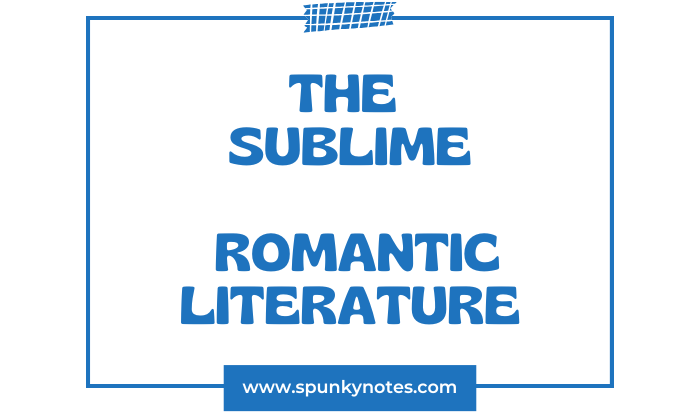 Q. Explain the concept of the “sublime” in Romantic literature. Which Romantic writers emphasized this idea, and how did they portray it?
Q. Explain the concept of the “sublime” in Romantic literature. Which Romantic writers emphasized this idea, and how did they portray it?
The Sublime in Romantic Literature
In Romantic literature, the “sublime” represents a feeling of awe mixed with fear, often inspired by nature or grand landscapes. Romantic writers used the sublime to express powerful emotions that transcend ordinary experiences.
They aimed to capture the overwhelming beauty and danger found in the natural world. These feelings of wonder and terror often reflect the mysteries of life and human existence.
The sublime became an important theme for Romantic writers who wanted to explore intense emotions. The idea is rooted in philosophy and aesthetics, but Romantic poets brought it to life through vivid descriptions and intense scenes.
They felt that the sublime could connect people to emotions beyond everyday understanding. This connection brought humans closer to something greater than themselves, often hinting at nature’s spiritual power.
For the Romantics, the sublime wasn’t just a beautiful view. It was an experience that pushed them to think deeply and feel intensely. Romantic poets and writers often described scenes where nature’s power seemed limitless.
This concept also helped them question humanity’s place in the world, emphasizing how small human beings could feel against the vastness of nature.
Origins of the Sublime
Edmund Burke
Philosopher Edmund Burke heavily influenced the concept of the sublime. In his book A Philosophical Enquiry into the Origin of Our Ideas of the Sublime and Beautiful (1757), Burke described the sublime as provoking strong emotions, especially fear and awe.
He argued that the sublime is different from beauty, which is pleasant and comforting. The sublime is vast, powerful, and sometimes frightening, stirring amazement and wonder. These ideas influenced many Romantic writers, who sought to create similar emotions in their readers.
Immanuel Kant
The Romantics were also influenced by Immanuel Kant’s ideas on the sublime. Kant viewed the sublime as an experience where the mind tries to grasp something vast or overwhelming, like a stormy sea or a mountain range.
According to Kant, this feeling forces the mind to recognize its limits. This concept gave the Romantics a framework to describe the powerful emotions they experienced when they observed nature’s grandeur.
Both Burke and Kant inspired Romantic writers to create moments of the sublime in their works. They saw the sublime as a way to break free from ordinary thoughts and emotions.
William Wordsworth
William Wordsworth was a key Romantic poet who emphasized the sublime in his work. He saw the sublime in nature as a source of spiritual awakening.
For Wordsworth, nature was not just scenery but a powerful force that inspired inner growth and reflection. His poems often describe encounters with nature that move him deeply.
In his poem Lines Composed a Few Miles Above Tintern Abbey, Wordsworth describes how nature fills him with feelings that are both beautiful and overwhelming.
He reflects on how nature has healing power and can connect the human spirit to a larger world. The hills, rivers, and woods around him inspire awe and remind him of life’s vastness and depth.
Through these natural settings, Wordsworth shows how the sublime can inspire both peace and wonder.
Wordsworth believed that nature could reveal truths about life and the self. His poems often suggest that people could experience feelings beyond words by observing nature.
In The Prelude, he describes encounters with wild landscapes that provoke powerful emotions. These moments shape his thoughts and identity, suggesting that the sublime is a path to understanding oneself.
Samuel Taylor Coleridge
Samuel Taylor Coleridge also explored the sublime, but he often focused on its darker side. Coleridge describes terrifying nature scenes in his famous poem The Rime of the Ancient Mariner.
The poem’s stormy seas and endless ice provoke fear and awe. Coleridge uses these elements to show nature as both beautiful and dangerous.
In Coleridge’s view, the sublime had a mysterious quality. He described nature as a force that humans cannot control or fully understand. This theme of the unknown gives his work a haunting atmosphere.
For Coleridge, the sublime was not just an inspiring experience but also a reminder of human vulnerability.
Coleridge also explored the sublime in Kubla Khan, where he describes a mysterious and foreign landscape. The poem’s images of caverns and rivers create an intense, dreamlike setting.
In this strange world, the sublime appears as something both wonderful and weird. Coleridge uses these images to remind readers of nature’s power and mystery.
Percy Bysshe Shelley
Another Romantic poet, Percy Bysshe Shelley, used the sublime to illustrate nature’s overwhelming power. In his poem Mont Blanc, Shelley describes a mountain as something beyond human reach and understanding.
He reflects on how the mountain’s grandeur and silence can make people feel small. Mont Blanc’s vastness shows that nature is eternal, while humans are temporary.
Shelley also suggests that the sublime connects people to something infinite. When he observes nature’s power, he sees a stronger and more lasting force than any human achievement.
This idea is also present in Ozymandias, where Shelley describes a fallen statue in the desert. The vast desert symbolizes nature’s power to erase even the greatest empires.
Shelley’s use of the sublime often emphasizes humanity’s limits. He suggests that humans are only a small part of a larger universe.
Through his poetry, he shows how the sublime can inspire both admiration and humility. In its grand and powerful form, nature stands as a reminder of forces beyond human control.
Lord Byron
Lord Byron also emphasized the sublime, primarily through the theme of wild landscapes. In poems like Childe Harold’s Pilgrimage, Byron describes scenes of mountains and vast waters.
His language reflects a sense of freedom and intensity, often drawing on his own adventurous spirit. Byron’s sublime landscapes are wild and untamed, mirroring his own restless nature.
Byron’s connection to the sublime often appears in his fascination with storms and dangerous settings. He portrays nature as a force that matches his characters’ intense emotions.
Byron’s poetry shows how the sublime can inspire both awe and a sense of liberation. His characters often face nature’s power with admiration and defiance, reflecting their inner struggles.
For Byron, the sublime is a way to express independence and courage. His descriptions of nature’s power align with his own desire for freedom. In this sense, Byron’s sublime is not just about awe but also about strength and resilience.
Conclusion
The sublime in Romantic literature highlights both beauty and power in nature. Romantic poets saw the sublime as a way to connect deeply with feelings and ideas beyond the ordinary.
Writers like Wordsworth, Coleridge, Shelley, and Byron used the sublime to convey their intense experiences with nature. Each poet had a unique approach, but they all viewed the sublime as something that could inspire, humble, and even frighten.
Wordsworth found the sublime’s peaceful strength, while Coleridge saw it in mystery and terror. Shelley used it to show the vastness of the universe, and Byron used it to express freedom.
For the Romantics, the sublime was more than just a theme; it was an essential way to understand the world and humanity’s place.

